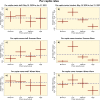A study of SARS-COV-2 outbreaks in US federal prisons: the linkage between staff, incarcerated populations, and community transmission
- PMID: 35277142
- PMCID: PMC8916071
- DOI: 10.1186/s12889-022-12813-w
A study of SARS-COV-2 outbreaks in US federal prisons: the linkage between staff, incarcerated populations, and community transmission
Abstract
Background: Since the novel coronavirus SARS-COV-2 was first identified to be circulating in the US on January 20, 2020, some of the worst outbreaks have occurred within state and federal prisons. The vulnerability of incarcerated populations, and the additional threats posed to the health of prison staff and the people they contact in surrounding communities underline the need to better understand the dynamics of transmission in the inter-linked incarcerated population/staff/community sub-populations to better inform optimal control of SARS-COV-2.
Methods: We examined SARS-CoV-2 case data from 101 non-administrative federal prisons between 5/18/2020 to 01/31/2021 and examined the per capita size of outbreaks in staff and the incarcerated population compared to outbreaks in the communities in the counties surrounding the prisons during the summer and winter waves of the SARS-COV-2 pandemic. We also examined the impact of decarceration on per capita rates in the staff/incarcerated/community populations.
Results: For both the summer and winter waves we found significant inter-correlations between per capita rates in the outbreaks among the incarcerated population, staff, and the community. Over-all during the pandemic, per capita rates were significantly higher in the incarcerated population than in both the staff and community (paired Student's t-test p = 0.03 and p < 0.001, respectively). Average per capita rates of incarcerated population outbreaks were significantly associated with prison security level, ranked from lowest per capita rate to highest: High, Minimum, Medium, and Low security. Federal prisons decreased the incarcerated population by a relative factor of 96% comparing the winter to summer wave (one SD range [90%,102%]). We found no significant impact of decarceration on per capita rates of SARS-COV-2 infection in the staff community populations, but decarceration was significantly associated with a decrease in incarcerated per capita rates during the winter wave (Negative Binomial regression p = 0.015).
Conclusions: We found significant evidence of community/staff/incarcerated population inter-linkage of SARS-COV-2 transmission. Further study is warranted to determine which control measures aimed at the incarcerated population and/or staff are most efficacious at preventing or controlling outbreaks.
Keywords: Community; Coronavirus; Decarceration; Disease intervention strategies; Inmates; Pandemic; Prisons; SARS-COV-2.
© 2022. The Author(s).
Conflict of interest statement
The authors declare no competing interests.
Figures



Similar articles
-
Is There a Temporal Relationship between COVID-19 Infections among Prison Staff, Incarcerated Persons and the Larger Community in the United States?Int J Environ Res Public Health. 2021 Jun 26;18(13):6873. doi: 10.3390/ijerph18136873. Int J Environ Res Public Health. 2021. PMID: 34206845 Free PMC article.
-
COVID-19 Infection Among Incarcerated Individuals and Prison Staff in Lombardy, Italy, March 2020 to February 2021.JAMA Netw Open. 2022 Mar 1;5(3):e224862. doi: 10.1001/jamanetworkopen.2022.4862. JAMA Netw Open. 2022. PMID: 35353164 Free PMC article.
-
COVID-19 community spread and consequences for prison case rates.PLoS One. 2022 Apr 13;17(4):e0266772. doi: 10.1371/journal.pone.0266772. eCollection 2022. PLoS One. 2022. PMID: 35417500 Free PMC article.
-
Managing COVID-19 outbreaks in prisons - a brief review of literature and key lessons learnt.Int J Prison Health (2024). 2024 Oct 17;ahead-of-print(ahead-of-print):410-421. doi: 10.1108/IJOPH-08-2023-0049. Int J Prison Health (2024). 2024. PMID: 39410814 Review.
-
Investigation of a COVID-19 outbreak at a regional prison, Northern Uganda, September 2020.Pan Afr Med J. 2022 Sep 6;43:10. doi: 10.11604/pamj.2022.43.10.33598. eCollection 2022. Pan Afr Med J. 2022. PMID: 36284891 Free PMC article. Review.
Cited by
-
Importance of occupation for SARS-CoV-2 seroprevalence and COVID-19 vaccination among correctional workers in Quebec, Canada: A cross-sectional study.Front Public Health. 2022 Nov 9;10:1021871. doi: 10.3389/fpubh.2022.1021871. eCollection 2022. Front Public Health. 2022. PMID: 36438247 Free PMC article.
-
Decarceration and COVID-19 infections in U.S. Immigration and Customs Enforcement detention facilities: a simulation modeling study.Lancet Reg Health Am. 2024 Dec 27;42:100971. doi: 10.1016/j.lana.2024.100971. eCollection 2025 Feb. Lancet Reg Health Am. 2024. PMID: 39830893 Free PMC article.
-
Diagnosis, Treatment, and Prevention of HIV Infection among Detainees: A Review of the Literature.Healthcare (Basel). 2022 Nov 27;10(12):2380. doi: 10.3390/healthcare10122380. Healthcare (Basel). 2022. PMID: 36553904 Free PMC article. Review.
-
The Impact Of COVID-19 On The Health Of Incarcerated Older Adults In California State Prisons.Health Aff (Millwood). 2022 Aug;41(8):1191-1201. doi: 10.1377/hlthaff.2022.00132. Health Aff (Millwood). 2022. PMID: 35914202 Free PMC article.
-
The COVID-19 pandemic behind bars: Experimental evidence showing higher support for decarceration when framed as risk to correctional staff.SSM Popul Health. 2022 Sep;19:101218. doi: 10.1016/j.ssmph.2022.101218. Epub 2022 Aug 28. SSM Popul Health. 2022. PMID: 36059374 Free PMC article.
References
Publication types
MeSH terms
Grants and funding
LinkOut - more resources
Full Text Sources
Medical
Miscellaneous

